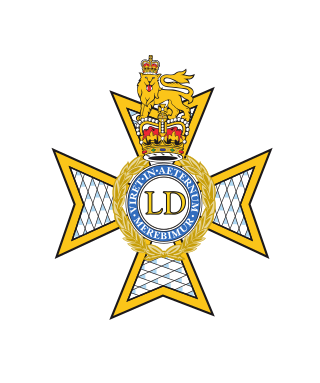The Infantry of the British Army comprises 49 infantry battalions, from 19 regiments. Of these, 33 battalions are part of the Regular army and the remaining 16 a part of the Army Reserve. The British Army's Infantry takes on a variety of roles, including armoured, mechanised, air assault and light.
Options for Change was a restructuring of the British Armed Forces in summer 1990 after the end of the Cold War.

The Light Dragoons (LD) is a cavalry regiment in the British Army. The regiment has a light cavalry role and specialises in mounted and dismounted reconnaissance. The Light Dragoons recruit mainly in Northern England, from County Durham, Northumberland, Tyne and Wear, South Yorkshire and the East Riding of Yorkshire. For this reason, the regiment is known as "England's Northern Cavalry". It is currently based in Catterick Garrison, North Yorkshire.
The following units of the German First Army and British Expeditionary Force fought in the Battle of Mons in World War I.
The 1957 White Paper on Defence was a British white paper issued in March 1957 setting forth the perceived future of the British military. It had profound effects on all aspects of the defence industry but probably the most affected was the British aircraft industry. Duncan Sandys, the recently appointed Minister of Defence, produced the paper. The decisions were influenced by two major factors: the finances of the country and the coming of the missile age.
Operation Telic was the codename for British operations in Iraq, which lasted from 19 March 2003 to 22 May 2011. During the campaign, 179 British service personnel and at least three UK Government civilian staff died.

The British Expeditionary Force order of battle 1914, as originally despatched to France in August and September 1914, at the beginning of World War I. The British Army prior to World War I traced its origins to the increasing demands of imperial expansion together with inefficiencies highlighted during the Crimean War, which led to the Cardwell and Childers Reforms of the late 19th century. These gave the British Army its modern shape, and defined its regimental system. The Haldane Reforms of 1907 formally created an Expeditionary force and the Territorial Force.
In countries whose armies are organised on a regimental basis, such as the army of the United Kingdom, a regimental museum is a military museum dedicated to the history of a specific army regiment.
This is the order of battle for the First Battle of Ypres fought from 19 October to 22 November 1914 as one of the main engagements of the First World War. It was fought between mixed British Expeditionary Force, French eighth army and armies of the German Empire in northern France and Flanders.
The following units of the British, French and German Empires fought in the First Battle of the Marne from 5–12 September 1914 on the Western Front of World War I.
In September 1939, the British Army was in process of expanding their anti-aircraft and mobile assets. Among these new changes was the formation of Anti-Aircraft Command which was formed on 1 April 1939, and the 1st Armoured Division formed in 1937. The list below will include the British Army units, colonial units, and those units which were in the process of formation.

The following is a list of the notable Regimental Marches for military regiments of the British Army. In addition, all regiments have additional pieces for slow marches, marches for mounted parades and pipe marches.
During the First World War the British Armed Forces was enlarged to many times its peacetime strength. This was done mainly by adding new battalions to existing regiments. Although sometimes identified by shoulder titles, generally the new battalions could not be identified from appearance. Consequently, the units in this list have been assembled considering only those as having a uniquely different cap badge.
This is a Bibliography of World War military units and formations. It aims to include historical sources and literature about specific unit formations of World War II, such as fronts/army groups, field armies, army corps, divisions, brigades, regiments, battalions, and companies. It also includes air force formations, such as air divisions, air groups, air wings, air squadrons and air force flights. Furthermore, it includes naval formations, such as naval divisions, naval squadrons, flotillas, carrier battle groups, naval task forces and naval fleets.



